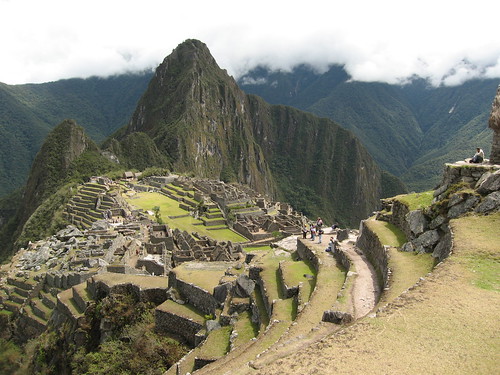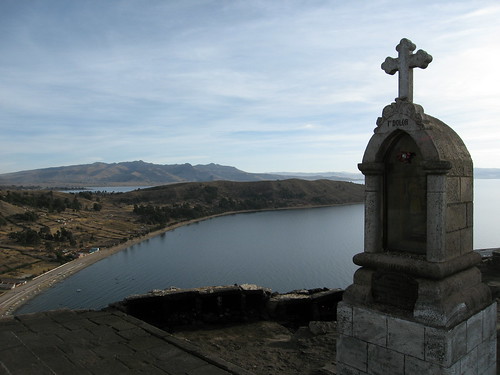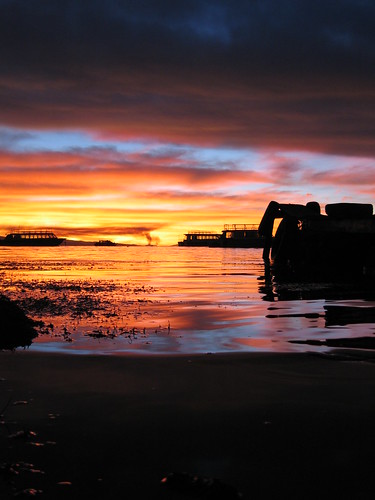
:: Looking down as Machu Picchu is revealed ::
So, after a brief stop at the Peruvian border and a change of coach in Puno we found ourselves on a bus up to Cusco. It's been several years since I was last in Cusco but it's changed in many ways. The most obvious change is how flash and well heeled it's all become. Gone from the main square are all the backpacker restaurants playing movies all day long. They've been replaced by very swish restaurants, coffee shops and pizza parlours. Thankfully, famous Gringo Alley with cheap and cheerful restaurant still exists and the number of hotels has risen dramatically so the squeeze for accommodation is gone. Our top finds in Cusco were our accommodation with a rooftop view over the square and our discovery of a jam packed local pizza joint that served very tasty wood fired pizzas.
Cusco is of course the famous jumping off point to access
Machu Picchu, our time there coincided with a train strike, so no trains were going to
Aguas Calientes, the town at the base of
Machu Picchu. Lots of agencies were offering bus tours so we started enquiring into them. After a lot of confused information we finally realised that the only way of getting to
Machu Pichhu is by train (there is no road) and the train tickets are outrageously expensive despite having three different classes of service. There is a complicated back door way of getting there that takes 2-3 days and involves catching buses in the middle of the night and walking along the train tracks for hours etc. I went to the official tourist office in
Cusco and the girl actually explained this option with a straight face. Ordinarily with time on our side we would have opted for this route. Annoyingly Peru rail have the whole thing sewn up and are very obviously cashing in on tourists. There are high class carriages, super high class carriages and then ordinary carriages full of locals. Some tourists will always want to take the comfortable more expensive option but it's unfair to not provide a reasonably priced option to budget travellers.

:: Well worth the effort ::
Anyhow, we swallowed the cost, made our way to Ollanytambo connected with our swish train and arrived into Aguas Calientes in time to buy entrance tickets for Machu Picchu for the following morning. At the early hour of 4am we began the long walk up hundreds of steps up into the entrance. Competitive elbowing and jostling was in full swing in the queue at the entrance as people waited impatiently for the gates to be thrown open so we could all foot race to the other side of the site to get into a second queue to be one of the 200 people allowed to climb up Wanupicchu daily (the big mountain you see in photographs behind the ruins). It was a shame really, very few people looked around them and admired a tranquil, empty, pre-tourist filled Machu Picchu.
A steep, sheer, one hour rope-aided uphill clamber later, and we were atop Wanupicchu and into the clouds. We all found a perch at very (small) summit and could see nothing but mist all around. Needless to say this didn't seem to be good. Who knew if or when the clouds would lift - and we were facing a timeline - we had to see the rest of the site and make it back down the path to our afternoon train out. Magically, fantastically and dramatically, after 25 minutes or so the clouds began to melt away underneath us as the morning air warmed and the awesome site of Machu Picchu was slowly revealed hundreds of metres below. In hindsight you could not hope for a better way to first lay eyes on the site. It was breathtaking, one of our real emotional visual highlights. The birds eye vantage point makes the experience; you can see the full scale and precarious positioning of the site on its mountaintop. You find yourself continuously asking, how ? and why ?. Honestly, its hard enough for us to get there and see it now, you cannot imagine how the Incas would have gone about constructing such a marvel. Scrambling back down we joined the throngs of visitors visiting the site and getting eaten alive by invisible insects.
Our visit to Machu Picchu came to and end and we raced back down to Aguas Calientes to catch the 2pm train back towards Cusco. We also had the pleasure of travelling tourist class, one step up from backpacker class. One enjoys frills such as a glass roof vista and free sandwich.... the extras didn't stop there. After handing out the food our carriage attendants proceeded to change into costumes and perform an interpretive dance down the aisle of the train. It all went from bad to worse when it was closely followed by a full on fashion show of Alpaca wool merchandise for sale on board. A quick superman change of clothes in the toilet and then they'd strut down the aisle, twirl in the doorway space and strike a pose. Clapping and wolf whistling from fellow passengers clearly demonstrated some people were thrilled with the extra services the tourist class train provides.
We took an overnight bus down to the friendlier altitudes of Lima city and the not so friendly surrounds of the capital's bus station area where stall upon stall peddles switch blade knifes, batons, fake real looking guns and other such weaponry. Moving into the nicer old surrounds of the city centre we threw our energy into getting some good
Chinese food in Lima's
Chinatown and hunting around for some good
ceviche.

:: Ceviche ::
As it happens Lima was all about the
ceviche, a large portion of the market was dedicated to it. Specialist after specialist serve up their take on the dish to hundreds of locals. We spend a couple of days sightseeing, the highlights being the Inquisition Museum and the catacombs filled with hundreds of skulls and bones rather artfully displayed. Embarrassingly we also whiled away a few hours in
Exito supermarket - it had been a while and the novelty value of being able to walk up and down aisles of fully stocked products was running high! It also had an extraordinary number of sampling stalls manned by very pushy staff that were only too delighted to hand out the latest and greatest products.
Travelling north from Lima we reached the Tumbes and the nightmare border between Peru and Ecuador. It's a tricky border due to it's layout, there is no solid immigration demarcation line between the two countries. There's a bridge and a sign that let you know you've crossed over but the official stamping of passports occurs in office locations kilometres away. People constantly make the mistake of crossing the bridge only to find out out the border officials are a outrageously priced taxi ride away. The trouble free approach is to take a cheap international bus right across the border that stops in the immigration offices along the way and takes the headache and risk out of the crossing. Even with this knowledge we were apprehensive when we were a good fifteen minutes drive inside the Ecuadorian border and we still hadn't seen an official outpost. When we did eventually got there it was an annoying experience. Only one window of potentially three was serving an enormous queue of people, processing per person was more than five minutes and during that wait time applicants were further irritated by the sight of four border guards sitting behind in the office, feet on a table reading newspapers.

